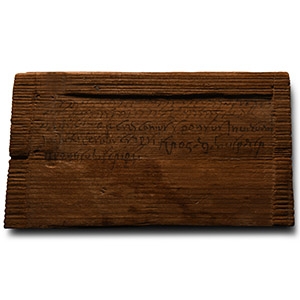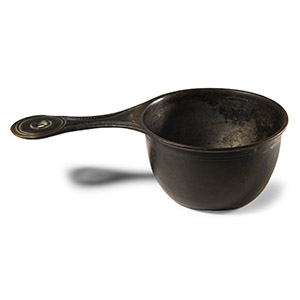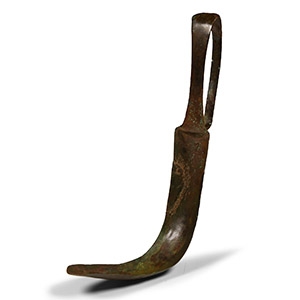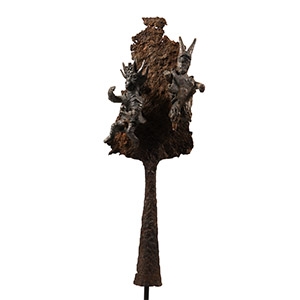Home > Auctions > 4 June - 8 June 2024
Ancient Art, Antiquities, Natural History & Coins
Auction Highlights:
From the West German collection of H.W.
Acquired from the De Mynter, Belgium, in 2011.
with Gorny and Mosch, Munich, 3 June 2017, no.52.
Private Portuguese R.M. collection.
Accompanied by a previous catalogue information slip.
Cf. Miše, M., Gnathia and related Hellenistic Ware on the East Adriatic Coast, Oxford, 2015, fig.5, p.45, for similar.
The kernos can be recognised by a series of small cups on the lip, with examples dating back to the Bronze Age. It was used to store offerings made to the gods, specifically in cults pertaining to Demeter and Persephone. The receptacles probably contained foodstuffs, or perhaps flowers, and a lamp was sometimes placed in the centre. Kernoses, such as this, were often carried in processions at the Eleusinian Mysteries (secret initiation rites celebrating the goddesses Demeter and Persephone) and were an important object for Greek religious life. Kernoses are thus closely related to the agrarian cult and to the myth of Persephone and Demeter, the goddess of fertility and agriculture. The myth is recounted in an Homeric Hymn (c. 650 B.C.) according to which Persephone, Demeter’s daughter, was seized by Hades, the king of the underworld, who brought her to his kingdom to make her his wife. Distraught, Demeter caused a terrible drought, which continued until Persephone returned to her mother from the underworld. Having consumed pomegranate seeds whilst she was in the Underworld, she was only able to be with her for a few months of the year.
Ex Marinescu-Roth-Virzi collection, Switzerland, 1970-1993.
Accompanied by a copy of a photograph of the artefact on display.
From the private collection of a London gentleman, from his grandfather's collection formed before the early 1970s.
Acquired on the German art market, 1989-1995.
with The Museum Gallery, 19 Bury Place, London, WC1A 2JB, 1998-2003.
Property of a London based academic, 2003-present.
This lot has been checked against the Interpol Database of stolen works of art and is accompanied by a search certificate no.12061-217502.
Cf. Richter, G.M.A., The Metropolitan Museum of Art, Greek, Etruscan and Roman Bronzes, New York, 1915, nos.784, 787, 789, for similar.
These kind of mirrors consisted of heavy circular discs with low cylindrical rims. They were made in pairs, and polished (and sometimes silvered) respectively on the recessed and flat sides, the latter being provided with a bevelled edge, into which the other fitted like a cover. Both polished surfaces were thus protected. The unpolished sides were ornamented with concentric-circle ornaments and concentric mouldings.
Found City of London, UK.
Acquired from mudlark Steve Brooker in the early 2000s.
Ian Wilkinson collection, Nottinghamshire, UK, formed since 1985.
Accompanied by several original handwritten letters regarding the conservation of the shoes.
This lot has been checked against the Interpol Database of stolen works of art and is accompanied by a search certificate number no.12093-214631.
Cf. van Driel-Murray, C., A late Roman assemblage from Deurne (Netherlands), in Bonner Jahrbücher, 2000, p.296-8, for discussion; Leguilloux, M., Le cuir etla pelletterie à l'époque Romaine, Paris, 2004, pp.109,115,123, for similar types.
Exhibited at Harwich Museum, Harwich, Essex, UK, 14th March-9th June 2024; accompanied by a copy of a photograph of the artefacts on display.
In Great Britain, examples of carbatinai dated to the last quarter of the 1st century A.D. have been found in Castleford. Others dated to the 2nd century have been found in London and Bar Hill. Carbatinae were often worn by children: two well-preserved specimens were discovered at the Vindolanda fort, which housed a mixed population of soldiers and their families.
From the old collection of Colonel Ronde, circa 1980s.
Property of a French collector.
This lot has been checked against the Interpol Database of stolen works of art and is accompanied by a search certificate number no.12094-214901.
Cf. similar pyxis in style with a putto in the Metropolitan Museum of Art, New York, accession number: 23.160.61a, b.
According to archaeologists, the pyxis could have served as a container for cosmetics, medicinal ointments, or perfume. Soldiers’ posessions often included carved vessels and lathe-turned bowls, spoons, spatulas, knives, discs and lids, as well as pyxides, which have been found in high numbers in military camps.
From an important London collection since 1975.
Accompanied by a collection of eight 1970s photographs of the the tablet.
Cf. Rothenhöfer, P., Blänsdorf, Jürgen, Sana mente sanaque memoria testa-mentum feci: Eine testamentarische Verfügung vom 12. April 340 n. Chr., Gephyra 13, 2016, pp.153-163; Rothenhöfer, P., Neues zum Testament des Pomponius Maximus aus dem Jahr 371 n. Chr., (forthcoming); see also Masi Doria, C., Dal testamento di Pomponius Maximus: prospettive del diritto ereditario tardo antico, in: Isola, L. (ed.), Klauselgestaltungen in Römischen Testamenten, Berlin, 2022, pp.151-175; also see Thomas, J. D., Vindolanda: The Latin Writing Tablets, Britannia Monograph Series No 4, London, 1983, for examples of wooden tabulae re-used as writing surfaces; for examples of testamentary documents on wooden tablets that have survived, see FIRA III, p.47, for Anthony Silvanus from 142 AD, also see BGU VII 1695 for Safinnius Herminus; for another from Transfynydd, North Wales, see Arch. Camb. 150, pp.143-156; and see Bowman, A.K., Life and letters on the Roman frontier : Vindolanda and its people, London, 1994, for discussion of the uses of Roman writing tablets.
Rothenhoefer, P., Neue römische Rechtsdokumente aus dem Byzacena-Archiv / New Roman Legal Documents from the Byzacena Archive, (forthcoming).
The contract follows the standard Roman legal formulae.
From an important London collection since 1975.
Accompanied by a collection of six 1970s photographs of the the tablet.
Cf. Rothenhöfer, P., Blänsdorf, Jürgen, Sana mente sanaque memoria testa-mentum feci: Eine testamentarische Verfügung vom 12. April 340 n. Chr., Gephyra 13, 2016, pp.153-163; Rothenhöfer, P., Neues zum Testament des Pomponius Maximus aus dem Jahr 371 n. Chr., (forthcoming); see also Masi Doria, C., Dal testamento di Pomponius Maximus: prospettive del diritto ereditario tardo antico, in: Isola, L. (ed.), Klauselgestaltungen in Römischen Testamenten, Berlin, 2022, pp.151-175; also see Thomas, J. D., Vindolanda: The Latin Writing Tablets, Britannia Monograph Series No 4, London, 1983, for examples of wooden tabulae re-used as writing surfaces; for examples of testamentary documents on wooden tablets that have survived, see FIRA III, p.47, for Anthony Silvanus from 142 AD, also see BGU VII 1695 for Safinnius Herminus; for another from Transfynydd, North Wales, see Arch. Camb. 150, pp.143-156; and see Bowman, A.K., Life and letters on the Roman frontier : Vindolanda and its people, London, 1994, for discussion of the uses of Roman writing tablets.
Rothenhoefer, P., Neue römische Rechtsdokumente aus dem Byzacena-Archiv / New Roman Legal Documents from the Byzacena Archive, (forthcoming).
The contract follows standard Roman legal formulae.
Acquired from Munich and London, 1990s.
From the collection of a London, UK, gentleman.
Accompanied by an academic report by Dr Raffaele D’Amato.
This lot has been checked against the Interpol Database of stolen works of art and is accompanied by a search certificate number no.12064-217904.
Cf. Tassinari, S., La vaiselle de bronze, Romaine et Provinciale, au musée des antiquités nationales, Paris, 1975, figs.3,5,6,7,8,9, for similar vessels; Boucher, S. & Tassinari, S., Musée de la Civilisation Gallo-Romaine a Lyon: Bronzes Antiques I. Inscriptions, Statuaire, Vaisselle, Lyon, 1976, item 360, for type; Boucher, S. and Tassinari, S., Bronzes Antiques I, Inscriptions, Statuaire, Vaisselle, Paris, 1976, p.117, no.132, for similar; cf. also The British Museum's Portable Antiquities Scheme, record id. GLO-048BB1, for a very similar example and additional information; see also Nico, V., La tavola degli Antichi, Milano, 1989, for discussion on these vessels.
The owner of the patera seems to be a certain Licinius. In contrast to more elaborate counterparts, paterae such as this were likely carried as part of the standard kit of Roman soldiers, used as a general cooking and eating utensil.
Ex collection Dr. Kuhn-Lucht, Germany.
with Kölner Munzkabinett, Cologne, before 2016.
Private European collection.
An emblematic instrument of the ancient sporting world, the strigil was mainly used by athletes as a scraper for personal hygiene. After training, which took place in the gymnasiums on tracks and arenas covered with sand, athletes and young people rubbed their skin with olive oil. They then used one of these distinctive scrapers remove the sand-oil mixture before washing in water. These actions are reproduced on famous statues (including Apoxyomenos, one of Lysippus’ masterpieces), on reliefs (such as funerary steles) as well as on countless vase paintings. In Attic and Italian red-figure imagery, the strigil is often depicted on perfume vases, like the aryballos and alabastron.
From a collection acquired on the UK art market from various auction houses and collections mostly before 2000.
From an important Cambridgeshire estate; thence by descent.
Cf. similar spearhead in Toepfer K.M., Die römischen Feldzeichen in der Republik und im Prinzipat, Mainz, 2011, NZ11, from Saalburg.
The piece is reminiscent of the votive plates in the Dolichenus cult, or possibly of some other cult.
Old private British collection, pre-1965.
Property of a gentleman; acquired in the UK before 2000.
Accompanied by a copy of an old black and white photograph.
Accompanied by an academic report by Dr Raffaele D’Amato.
This lot has been checked against the Interpol Database of stolen works of art and is accompanied by search certificate number no.12034-215425.
Cf. Bailey, D.M., A catalogue of the lamps in the British Museum, IV, Lamps of metal and stone, and lampstands, London, 1996, nos. 3769-3781, for the typology; similar specimens are preserved in Berlin, see Bérard, C., Bronzes Hellénistiques et Romains, Lausanne, 1979, pl.119; a similar example from Saida has been published by Pirzio Biroli Stefanelli, L., Il Bronzo dei Romani, Rome, 1990, p.269, no.264; cf. also Rolland, H., Bronzes Antiques de Haute Provence, Paris, 1965, no.299; Petit, J., Bronzes Antiques de la collection Detuit, Paris, 1980, no.15; Oggiano-Bitar, Bronzes figurés antiques de Bouches-du-Rhône, Paris, 1984, no.232, from Marseille.
Exhibited at the Harwich Museum, Harwich, Essex, UK, 14th March-9th June 2024; accompanied by a copy of a photograph of the artefact on display.
Here Jupiter is represented with his attributes connected with the crescent of goddess Luna. According to Bailey, all lamps in the category to which the map belongs, were intended for suspension. Lamps with multiple nozzles gave more light and thus were suitable for lighting large spaces.
61 - 72 of 2809 LOTS

.jpg)

.jpg)
.jpg)
.jpg)


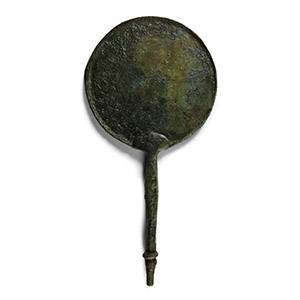
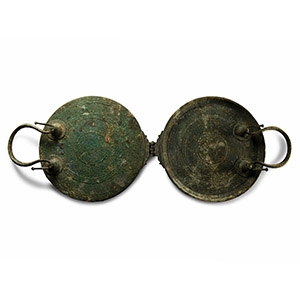
.jpg)

.jpg)
